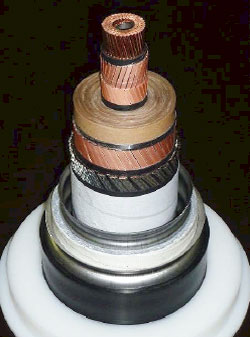Furukawa Electric Develops the World's Highest Standard for High-Temperature Superconducting Cables
- Their Integrity Is Confirmed through a Long-Term Current Load Test Equivalent to 30 Years -
As part of the NEDO project related to the technological development of superconductivity, Furukawa Electric's research team and others have developed high-temperature superconducting cables(Note 1) that enable power transmission at 275kV and 1.5 million kVA, which is the highest level of superconducting power transmission in the world. They have also developed an aerial terminal connector and an intermediate connector(Note 2) for connecting with electrical equipment, and conducted demonstration tests at Shenyang Furukawa Cable Co., Ltd.(Note 3) in Shenyang, China. In the demonstration test, a long-term current load was conducted in an acceleration test equivalent to 30 years,(Note 4) which successfully confirmed the soundness of the cable and connectors.
Technological development of superconducting power transmission cables has mainly focused on 66kV so far. However, demand has increased, mainly overseas, for cables capable of power transmission at even higher voltages. The establishment of these technologies is expected to lead to the adoption of these cables and connectors as a new infrastructure, not only in Japan, but also in other countries.
Overview
In order to realize a stable and efficient power supply system, which forms the basis of economies and societies, it is necessary to establish technologies to control power systems appropriately and stabilize the power supply, as well as highly efficient power transmission technologies to transport generated power without loss. In the Technological Development Project for Yttrium Superconducting Electrical Systems (project leader: Yu Shiohara, Director of the International Superconductivity Technology Center), NEDO has been working on developing superconducting cables, superconducting transformers, and other electrical equipment that uses high-temperature superconducting wires from rare earth oxides—of which a typical example is yttrium (generally referred to as yttrium superconducting wires)—which are expected to result in compact large-capacity power supply by utilizing the global cutting-edge superconductivity technologies that have been derived from the past technological development.
Current load tests are conducted as part of the project. For the 275kV high-temperature superconducting cable system, Furukawa Electric created high-temperature superconducting cables based on the following design specifications, utilizing the yttrium superconducting wires(Note 5) developed for the project: a diameter of 150mm, a transmission loss of 0.8W/m, and a voltage of 275kV. A system measuring 30m in total length was built in Shenyang, China.
After confirming the cable's initial performance in mid-October 2012, the cable was loaded with a 3kA current at a voltage of 200kV, completing the monthlong test at the end of December of that year. The cable was then loaded with a voltage of 310kV to confirm that no partial discharge could be seen from the deterioration of the cables. The results confirmed the soundness of the cable, aerial terminal connector, and intermediate connector.
Future prospects
Based on the results of this technological development, NEDO intends to continue striving to put these superconducting cable systems to practical use in the hopes of helping to resolve global environmental issues.
Furukawa Electric plans to obtain a number of detailed design data necessary for this practical application by conducting further tests under different conditions and long-term current load tests, as part of its efforts to put superconducting cables to practical use.
Reference: explanation of terms
(Note 1)High-temperature superconducting cable:
Superconductivity refers to a phenomenon in which electrical resistance becomes zero when the temperature falls below a certain point. Superconductivity is categorized into low-temperature superconductivity (metallic superconductivity), which uses liquefied helium (-269ºC) for cooling, and high-temperature superconductivity (oxide superconductivity), which uses liquefied nitrogen (-196ºC) for cooling.
A high-temperature superconducting cable is a power cable that uses high-temperature superconducting wire. Since it has a higher temperature than low-temperature superconductivity, fewer facilities are needed for cooling. This allows a compact form to be realized and cooling costs to be reduced.
Since the cable size is compact, the size and number of conduits for underground power transmission lines may be reduced. If put to practical use, the system is expected to significantly reduce the cost of building power distribution facilities, as well as enhance power transmission efficiency.
(Note 2)Terminal connector, intermediate connector:
The terminal and intermediate connectors are auxiliary parts necessary for connecting superconducting cables. The terminal connectors are attached on both ends of a cable to connect the superconducting cable to electrical facilities at ambient temperature. The intermediate connectors connect the superconducting cables each other, and are necessary to lay long-distance cables. Since the superconducting cables are cooled by liquefied nitrogen and the conducting body is under high voltage, the connectors need to compactly realize heat insulation between the liquefied nitrogen temperature and ambient temperature and electrical insulation between the ground and high-voltage parts.
(Note 3)Shenyang Furukawa Cable Co., Ltd.:
The company was established in 1995 as a joint venture of Furukawa Electric, Shenyang Cable Co., Ltd., and Itochu Corporation, and became a wholly owned subsidiary of Furukawa Electric in 2003 through a 100% investment. The company has a factory in Shenyang, China, and its scope of business includes the manufacture and sale of 66-500kV ultra-high voltage power cables and joints and other mechanical parts, along with cabling work. Its product design, manufacture, and quality management technologies were transferred from Furukawa Electric.
(Note 4)3Acceleration conditions equivalent to 30 years:
In order to verify a service life of 30 years in a long-term current load test during a month, a test is conducted by applying an initial withstand voltage of 200kV to ordinary operation voltage (160kV to ground), applying 3kA load cycle, equivalent to the load fluctuation at an actual use. This method applies the long-term current load test stipulated in the Japanese Electrotechnical Committee (JEC-3408) Standards.
(Note 5)Yttrium superconducting wire:
This wire is made by forming an intermediate film through Ion Beam Assisted Deposition (IBAD) method on the metallic substrate tape of chromium-nickel alloys, and then forming the film by crystallizing and synthesizing oxide superconducting material composed of rare earth (yttrium and others), barium, copper, etc.
The material reaches a superconducting state at a temperature of liquefied nitrogen (-196ºC). Its characteristics include a high current density, a low property decline even when placed under a magnetic field, and a small alternating current loss. It is the best-performing material among the high-temperature superconducting wires that have been put to practical application.









 Share
Share Tweet
Tweet Share
Share